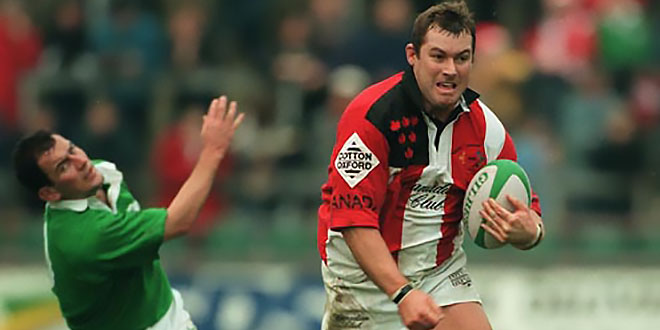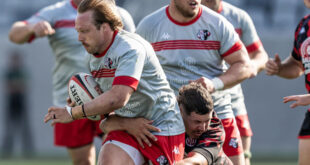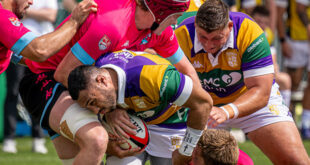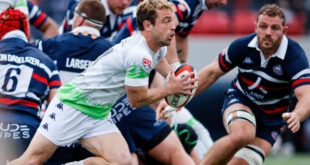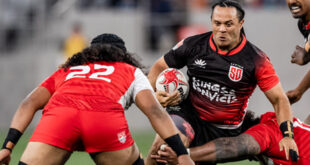Canada’s most capped lineup will require a slightly different approach with coaches over the years often shuffling players around leaving many caps spread over multiple positions. In more established countries specialisation is the norm but versatility remains a distinct feature of Canadian rugby players. It’s no surprise that most of the team is drawn from the professional era when many more test matches have been played by Canada, but there are a couple throwbacks to a simpler time when scrums set themselves and tries were only worth four points.
1 – Eddie Evans (49 caps, 47 starts) After making his debut in 1986 at the age of 22, a very young age for a prop at the time, Evans would be a regular in the Canadian lineup until being left out of the 1999 World Cup squad by coach Pat Parfrey. Stuck on 49 caps and now 35 years old, it was an unceremonious end to a tremendous career for the specialist loosehead. Evans was one of Canada’s first professional players, moving to Tokyo to play for IBM in 1992. Of course the sport had not yet turned professional, that would not happen until post-RWC 1995, but nobody actually thought he was there to do a desk job. Evans boasts wins over Argentina, France, and ‘XVs’ from Scotland and England that both contained British & Irish Lions. He also holds the distinction of having the second-highest winning percentage (61%) of any Canadian international, with only 20-times-capped scrumhalf Chris Tynan (75%) ahead of him. Former skipper Kevin Tkachuk actually won a few more caps at prop, 55 to be exact, but started only 39 of those.
2 – Pat Riordan (43 caps, 35 starts) Hooker has long been a problem position for Canada, in fact arguably the problem position. There have been good players, but when it comes to debating an all-time XV – or even a modern era team – there is always room for debate in the middle of the front row. Mark Cardinal was around the squad for 13 years but it was Riordan who staked the greatest claim over his eight years in test rugby. He made his debut in 2003 and usurped Aaron Abrams and Mark Lawson to become a permanent fixture in the side in 2006. New coach Kieran Crowley named him skipper for the first time against the Eagles in 2008 and he would remain in the role through the 2011 World Cup, which would be his international swansong.
3 – Rod Snow (62 caps, 59 starts) The Snowman famously made his test debut as a hooker against Argentina in 1995 when coach Ian Birtwell wanted a heavyweight pack to combat the fearsome Pumas scrum. It nearly paid off, with Canada losing by a mere three points, but he would make one only more appearance at hooker in his test career, ironically against Argentina in similar circumstances in 1998. Otherwise he was a dynamite prop, a converted no8 whose trademark runs in the loose were very much in the mold of a rampaging loose forward. Snow won his first dozen caps on the tighthead side of the scrum with Evans typically at loosehead. When Evans was dropped Snow switched to loosehead where he would win most of his remaining caps, though he did have a stint filling in for the injured Jon Thiel in 2006. Thiel is actually Canada’s most-capped tighthead, having started 36 times in the position and winning 44 caps in all.
4 –Jamie Cudmore (43 caps, 39 starts) If we were talking purely in terms of second row starts then John Tait would get the honour with 34 starts and 37 caps, but it seems disingenuous to leave out Cudmore who made 10 starts on the blindside flank in the days when Canada had multiple 2m giants to choose from. It’s also undeniable that ‘Cuddles’ could have had many more caps were it not for injury and overseas club commitments over the years. At 38 years old he is still wearing the Maple Leaf as proudly as any, but surely those days are approaching their end. Tyler Hotson actually has two more caps to his credit, and comes close to Tait with 33 starts in the engine room.
5 – Mike James (56 caps, 56 starts) The king of the second rows, the 1.98m (6’6′) physical specimen was one of Canada’s most revered players both domestically and abroad. He moved to France following the 1995 World Cup and stayed for more than a decade, starring for both Perpignan and perhaps most notably for Stade Français in Paris, where he won three French championships. James won a single cap on the blindside against Uruguay in 1995 but otherwise spent the entirety of his 13-year test career at lock. Like Cudmore, injury and club commitments left him out of the best part of three years of test rugby following the 2003 World Cup, with James returning to play a full part in the run-up to the 2007 tournament, his fourth World Cup.
6 – Al Charron (76 caps, 76 starts) Canada’s greatest ever forward is also their most capped player of all-time and tied with Gareth Rees on a record 25 caps as captain. The Ottawa, Ontario, native was part of a fearsome back row in the 1991 World Cup team that made reached the quarter finals and a near unanimous choice for a World XV following the tournament’s completion. Charron spent most of his early days on the blindside but also won several caps at lock and no8.
7 – John Hutchinson (50 caps, 43 starts) Tied with Charron for the most caps on the flank in Canadian history, Hutchinson made a record 40 consecutive test appearances for Canada between 1995 and 1999. At 1.93cm (6’4″) he was a big man for an openside flanker with his long stride catching many players by surprise. After spending five years in Japan playing for IBM and Suntory, Hutchinson slipped out of favor shortly after David Clark took over the coaching duties in 2000, with the Australian opting for smaller, more dynamic flankers like Gregor Dixon and Danny Baugh.
8 – Aaron Carpenter (75 caps, 59 starts) A broken arm suffered against Ireland in November scuppered the opportunity for Carpenter to overtake Charron as Canada’s most capped player of all time, at least for now. With more than 50 starts at no8 he has more than double that of Colin McKenzie and is fourth on Canada’s all-time try-scoring list, at 16 the only Canadian forwards to have touched down 10 or more times (Charron managed 9). Built like a front row and twice trialed as a hooker, it’s at the back of the scrum where Carpenter has played his best rugby, both internationally and professionally. At 34 years of age his time in a Canadian jersey is undoubtedly winding down but the record could yet be his when Canada play four tests this coming June.
9 – Morgan Williams (56 caps, 52 starts) Few Canadian players captivated an international audience like Williams, who exploded onto the scene in 1999, displacing veteran John Graf and earning himself the nickname ‘Le Petit Jaune’ from French fans for his bleached hair and ‘joie de vivre’ on the pitch. Despite contracts at some of Europe’s most exclusive clubs in Bordeaux, London, and Paris, Williams never quite reached the same heights in professional rugby as he did in the Canadian jersey. Nova Scotia’s greatest rugby export retired from international duty after the 2007 World Cup, his third, though he answered an SOS in November the following year to fill in after Phil Mack was injured before the European tour.
10 – Gareth Rees (55 caps, 54 starts) The current Rugby Canada Director of Everything might be jokingly mistaken for a retired prop these days, but in his heyday he was undoubtedly Canada’s most celebrated player internationally. He debuted as a teenager and went on to spend 13 years in the national side, calling it quits after the 1999 World Cup. Rees held Canada’s points scoring record until James Pritchard surpassed it in 2013, but he remains well ahead of contemporary rival Bob Ross for second spot. Ross won 58 caps during his own 14-year stay in the national side but generally had to play second fiddle to Rees, though the two were sometimes squeezed into the same lineup with one at inside centre to accommodate their superior tactical kicking skills.
11 – Winston Stanley (66 caps, 64 tests) Comfortably Canada’s most capped winger even though he started at fullback on 18 occasions, Stanley is also the all-time leader in tries scored with 24, though DTH van der Merwe now sits just one behind. Stanley was Canada’s best attacking player for a decade, and also starred in the seven-a-side version of the game. He famously won a Heineken Cup for Leicester in 2001, becoming the first and only Canadian to achieve the feat. He retired somewhat prematurely at the age of just 29 following the 2003 World Cup, and has since become an accomplished coach for various teams in Western Canada.
12 – Steve Gray (47 caps, 45 starts) It was three years in between making his test debut 1984 and his second start in 1987, but after scoring a hat-trick against the Eagles in Vancouver he would go on to be a mainstay in the Canadian side for another decade. At 1.75m (5’9″) he was small by today’s midfield standards, but deceptively strong and fiercely competitive. Like Evans he took part in several famous wins with only Ireland eluding him of the original Five Nations sides, though he came close in the 24-21 loss at Victoria in only his fifth international. He won his last cap against the Eagles as a replacement in 1997, just three weeks shy of his 34th birthday. Ryan Smith later won 51 caps in all but 13 were as a replacement and 11 at the flyhalf position.
13 – Ciaran Hearn (53 caps, 45 starts) Along with Cudmore and Carpenter one of three current internationals to have more than 50 caps, Hearn is tied with Gray for the most starts in a Canadian midfield at 31. Like Gray, he started his test career largely on the wing before settling into the midfield, and also featured heavily for Canada’s sevens side. His exploits in the shortened game kept Hearn out of professional rugby until he at last accepted an offer to join London Irish following the 2015 World Cup. His size has undoubtedly played a role in his success but it’s his deft footballing skills that have kept him at the peak of Canadian rugby since his debut in 2008.
14 – James Pritchard (62 caps, 48 starts) Sean Fauth is actually Canada’s second to Stanley in terms of starts on the wing with 28, while Dave Lougheed was predominantly a winger in his 34 test starts, but it’s counterfactual to name a most capped Canadian lineup without Pritchard, who only narrowly missed out on the fullback spot but also played wing on 16 occasions. Australian-born, he qualified for Canada via his grandfather but one would be hard-pressed to name a player more dedicated to the Maple Leaf during his 12-year tenure with the national side. Pritchard is Canada’s all-time scoring leader with 607 points, fifth highest with 62 caps, and one of a select few to have played in four World Cups.
15 – Scott Stewart (64 caps, 62 starts) A rugged and uncompromising player, Stewart had the ability to play in any backline position outside scrumhalf but it was fullback where he was at his best. His 45 caps at the back are four more than Pritchard achieved in a similar 12-year international career. Stewart played on the wing against New Zealand in the 1991 World Cup quarter final and at fullback in the infamous Port Elizabeth punch-up against the Springboks in 1995. Since his retirement in 2001 he has moved on to coaching, and is currently in his 14th season at the head of UCLA rugby.
 Americas Rugby News Rugby news from across the Americas!
Americas Rugby News Rugby news from across the Americas!
